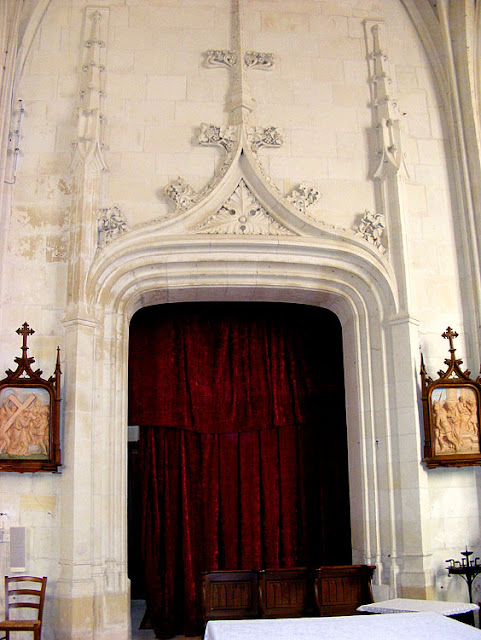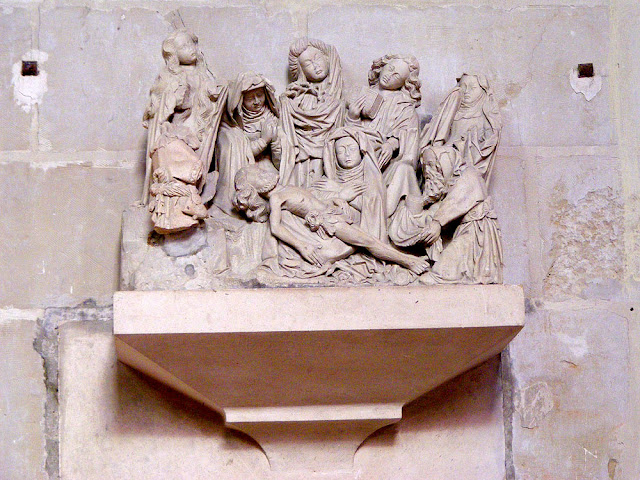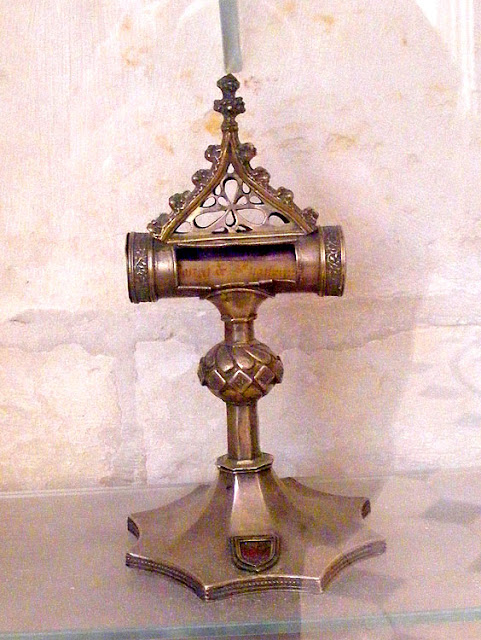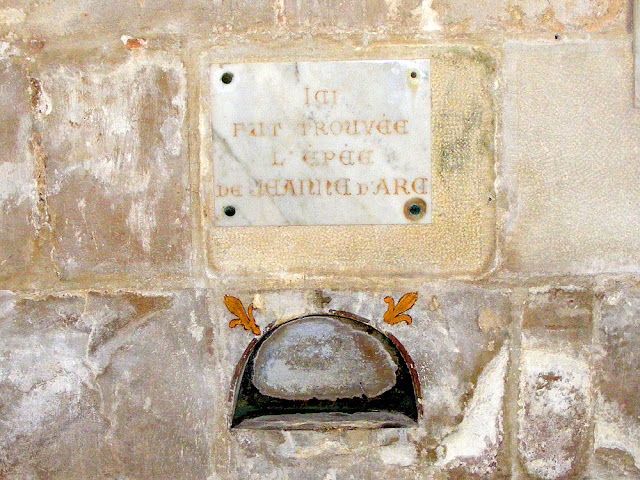The church in Sainte Catherine de Fierbois is a 15th century replacement for the original early medieval chapel which burnt down. According to legend Charles Martel left his sword behind the altar as a devotional gift after he defeated the Sarrasins in the Battle of Poitiers in the 8th century. This story is unlikely to be true, because although Saint Catherine of Alexandria is the patron saint of soldiers, she was not a recognised saint in France until after the Crusades, long after Charles Martel's time. Saint Catherine de Fierbois is several days journey away from Poitiers too, which makes it seem an even more unlikely story. Be that as it may, seven centuries later, Joan of Arc's voices, one of whom was Saint Catherine, told her to come and fetch the sword. Charles VII had arranged a suit of armour for her, but she refused his offer of a sword because she knew she would be shortly in possession of Charles Martel's rusty but legendary old sword. Joan had in fact been to the church before, and attended mass there when she was travelling to Chinon to see the young King. Some people find this significant...
 |
| Ceiling boss in the church, with what I think are Anne of Brittany's arms. |
Whilst waiting in Tours for her armour to be made, she sent one of the armourers to Sainte Catherine de Fierbois. Her voices told her the sword was buried but would be recognisable by five crosses on the hilt. She told how the man she sent to dig behind the altar refused to hand over the sword and she had to write to the ecclesiastical authorities to get it sent to her. The priests gave her a red velvet scabbard, the citizens of Tours gave her one made of cloth of gold, and she herself had a robust leather one made. The priests had cleaned the sword and found that the rust fell away with just a light brushing.
 |
| The front of the church. |
The chapel that Joan knew, which in reality was probably built in 1280 for pilgrims, was burnt down by the English in 1440 and was replaced with the current church in 1450. Charles VII had always intended to agrandise the chapel after Joan's death and plans and funds existed from 1431, but the building wasn't completed until his grandson's generation. For much of its life the association with Joan was played down, but interest grew in the mid-19th century, and became quite a strong movement after the Prussian War of 1870-71.
 |
| An internal door in the church. |
Saint Catherine was a popular saint, especially in the 16th century, and the church is on the pilgrim route to Saint Iago de Compostella in Spain, so the church has always received pilgrims, but not necessarily connected to Joan.
 |
| Internal doorway in the church. |
The church was restored in 1859, under the careful eye of the Amboise based architect Sylvain-Philippe Chateigner. It is pure Flamboyant Gothique in style, built in the form of a Latin cross, on the footprint of the former chapel. The place where Joan found the sword is indicated midway down the south wall. Stretching above it all is a 41 metre high bell tower.
 |
| View down the aisle of the church. |
Each side of the transept forms a chapel. On one side it is dedicated to Saint Catherine of Alexandria, with a 15th century altar that was retrieved in the 19th century from a nearby mill, after it had been sold during the Revolution. There is also a magnificent 19th century Gothic Revival confessional made by a local cabinetmaker, who also made the main altar. The church has about a dozen 19th century stained glass windows made by the Lobin workshop in Tours. The originals were destroyed in the Revolution. The other chapel is dedicated to the Madonna.
 |
| 19th century bronze statue of Joan of Arc in front of the church. |
Joan's sword mysteriously disappeared before she was captured and she appears unable to explain why she was armed with another completely different sword when she was captured. It was not the sword she offered up at Saint Denis, which she said was another one again. She said she lost the sword from Sainte Catherine de Fierbois.
 |
| A wonderful small 15th century sculpture depicting Christ being interred by his closest followers. |
In a niche to the right of the main altar are some reliquaries, including a handsome silver one with some gilding, containing one of Saint Catherine's finger bones. On a small wall plinth is a sculpture depicting the dead Christ being laid to rest by his closest followers. Both were commissioned by the Maréchal de France, Jean Boucicaut, in the early 15th century, originally for the chapel in the pilgrim hostelry he had built across the road. There is no indication of where these pieces were made.
 |
| Reliquaries in the church. |
In front of the church is a bronze statue of Joan, put there in 1895.
 |
| 15th century silver reliquary containing a finger bone of Saint Catherine of Alexandria. |
 |
| Banner and replica sword for Joan of Arc. |
 |
| The place where Joan's sword was found. |
We are also on Instagram, so check us out to see a regularly updated selection of our very best photos.

No comments:
Post a Comment